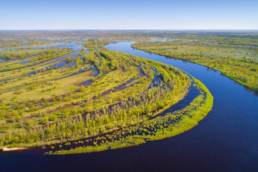Protection status matters: the case of Makove Bog – a virgin forest saved from destruction
The vast expanses of wild Polesia are full of surprises. Even after decades of research work, experts can’t claim to know the wildlife of this region inside and out. They are still discovering endangered species’ habitats (sometimes even those considered to be locally extinct), rare biotopes and, as it turned out, even vast areas of virgin forests! It is extremely important to give these natural values a legal protection status – this is a chance for them not to fall victims to human economic activity. The latest case from our project is a speaking proof to this.
The word ‘Polesia’ derives from the ancient proto-Slavic noun ‘les’ meaning ‘forest’. No wonder: even now, after centuries of natural and anthropogenic transformations, economic exploitation and urbanization, forests make up a significant share of the region’s area.
Among the diversity of Polesia’s ecosystems, old-growth forests stand out. There are a number of definitions of this concept, but they are essentially the same: a virgin forest is a forest of natural origin, formed by native species, with a complex age and spatial structure, capable of self-maintenance and self-regulation. The main criteria used to identify virgin forests are usually the presence of old trees, large amounts of dead wood in various stages of decomposition and the absence of economic activity for at least several decades. Of course, in all cases these forests are exceptionally rich in biodiversity, being the places where the rarest and most vulnerable species are concentrated. Old-growth forests perform a range of essential ecosystem functions: shaping weather and climate, purifying and conserving water, storing and sequestering carbon.
The most important characteristic of old-growth forests is their undisturbed nature. Any economic activity within their boundaries causes significant and often irrevocable disturbance, and sometimes even total destruction. Any form of logging, even the removal of deadwood or individual trees, actually leads to their destruction as old-growth forests. And once destroyed, virgin forests can never be restored, not even over many generations. The only possible mechanism for preserving such forests is a total ban on economic activity.

The total area of virgin forests in Polesia presumably amounts to several tens of thousands hectares. Interspersed with sparse forests on bogs and open bogs, which are also intact ecosystems, primeval forests form a complex spatial mosaic. There have been several attempts to find the last primeval forests in Polesia, and it is not an easy task. They are usually relatively small and fragmented, and the experts had to examine huge areas of forest affected by human activity in order to find the valuable areas subject to legal protection. Ukrainian environmental legislation provides for the creation of so-called “primeval forest natural monuments” with a total ban on economic activity.
In 2019-2021, an expedition to identify primeval forests in Ukrainian Polesia was organised as part of our project. During their work in the Rivne region, the specialists were surprised. Studying the documents describing the forest area known as Makove Bog, they expected to find a typical bog pine forest, with trees that were on average less than 110 years old and up to 15 metres high. But when they got there, they found that the trees looked much taller and older. In fact, core analysis showed that some were more than 150 years old. The almost complete absence of human activity and the abundance of dead wood proved that this was a natural, intact old-growth forest covering an area of 260 ha – a really large area for a Polesian primeval forest! Surprisingly, before the expedition, the area had never been explored and legally protected.

In December 2021, after completing all the necessary bureaucratic procedures, Makove Bog was granted an official protection status, with a total ban on any economic activity, including all kinds of logging, construction of any buildings, including elements of linear infrastructure, etc.
This case looked like a significant conservation victory, until at the end of 2023 the permit for peat extraction in Makove Bog for the next 20 years was auctioned by the Ukrainian government and bought for nearly $700,000. Unfortunately, this case is not unique in Ukraine: there have been other examples of the sale of permits for peat and amber mining in protected areas. Some of these deals have been cancelled by the Ministry of Environment, but not all.
Fortunately, the case of Makove Bog was brought to the attention of the specialised environmental prosecution service of the Ukrainian Prosecutor General’s Office. They stated that peat extraction in the area of designated virgin forest monument was a serious violation of national environmental legislation, as it would inevitably lead to the destruction of the unique natural object. The environmental prosecutors went to court and defended their position by proving that the use of Makove Bog for mining was illegal, using the high conservation status of the area as their main argument. The court agreed with their arguments and upheld the case. Now the prosecutors are also considering the establishment of protection zones around the nature monument.
We believe that this case is a significant conservation victory for Polesia’s wilderness, and a sound argument in favor of further identifying rare and valuable habitats and giving them legal protection. As we can see, without this work, unique ecosystems can be irreversibly disturbed or destroyed. And we may never even know it.
Our reference: more than 100,000 ha of natural areas in Polesia have been legally protected thanks to the efforts of our project.
Safe and intact: protecting rare and typical habitats in Polesia
19. September 2025
0 Comments7 Minutes









